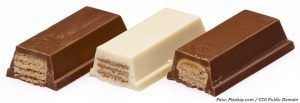Another defeat for the Swiss-based food giant Nestlé: The appeal against the decision of the High Court of England and Wales (EWHC) was rejected. KitKat can still not register the form of its “four-finger-bar” as a 3D trademark. The world market leader of the food industry Nestle has been trying to obtain a trademark protection claim for its well-known KitKat bar for a long time. They believe that the “iconic” form of KitKat deserves to be protected as a trademark. Here the whole story:
First registration successful, but Cadbury has something against it
T he first application went on 8 July 2010. The Uk Trademark Office took the view that the mark had no original distinctive character, but that the applicant had demonstrated that it had acquired distinctive character on the basis of its use. The british rival Cadburry, belonging to the Mondelez International Group, filed a protest against the acceptance of the application. On 20 June 2013, the entry into the class 30 of the NICE classification was then rejected. The Trademark was devoid of inherent distinctive character save for cakes and pastries and that it had not acquired a distinctive character in relation to any of the other goods.
he first application went on 8 July 2010. The Uk Trademark Office took the view that the mark had no original distinctive character, but that the applicant had demonstrated that it had acquired distinctive character on the basis of its use. The british rival Cadburry, belonging to the Mondelez International Group, filed a protest against the acceptance of the application. On 20 June 2013, the entry into the class 30 of the NICE classification was then rejected. The Trademark was devoid of inherent distinctive character save for cakes and pastries and that it had not acquired a distinctive character in relation to any of the other goods.
Nestlé appealed against the verdict and moved to the Court of Justice of the European Union (CJUEU). However, his judgment did not clearly answer the question of acquired distinctiveness. The appeal was therefore restored for the EWHC.
Chocolate bar not visible through packaging: No distinctive character
Nestlé’s petition was now again rejected two weeks ago by the EWHC. The reasoning of the judges states that the chocolate bar is not visible through the packaging. As a result, Nestlé can not prove the distinctive character of its chocolate. The fact that KitKat has had the same form since its founding in 1935 and therefore should be “protected as a trademark” is not sufficient as an argument from Nestlé’s side. Consumers link the form of the chocolate with KitKat though, but it is not the decisive criterion for the product as KitKat chocolate.
 But in the opinion of Roland Mallinson (Taylor Wessing) the final verdict is not yet taken: “It means that with some concerted use in this manner and fresh evidence, the shape could still be registrable with a new application. However, it is probably easier and cheaper for Nestle just to appeal and that seems the likely course”
But in the opinion of Roland Mallinson (Taylor Wessing) the final verdict is not yet taken: “It means that with some concerted use in this manner and fresh evidence, the shape could still be registrable with a new application. However, it is probably easier and cheaper for Nestle just to appeal and that seems the likely course”
Not the first “chocolate fight” for KitKat
That Nestlé and Cadburry are conflicting about chocolate trademarks isn’t something new. In 2013, Nestlé won a legal dispute against Cadbury and thus prevented the registration of its violet color of chocolate packaging in the trademark register.
In 2016 we have already reported on two similar cases: The mexican multinational bakery product manufacturing company “Grupo Bimbo” also failed to protect their shape for a chocolate candy (CLICK for the full article). Like in the case of KitKat they lacked distinctive character. The Mars Inc. on the other hand was successful with the registration of the 3D trade mark of the bounty chocolate bar. They were then able to enforce their trade mark against product from a turkish company (CLICK for the full article).
Protecting your Trademark against others
Your Trademark is (obviously) more distinctive and you want to protect it against competitors? Then let’s talk business today!
Request a callback without any obligations:
Source:
Text: EWCA Case A3/2016/0539
Pictures: Pixabay.com – photomontage by Dr. Meyer-Dulheuer & Partners LLP







